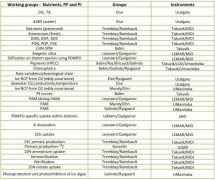Scientific work: measurement and sampling
Nearly 50 full-station sampling days at the 2015 ice camp, between mid-March and mid-July, made possible the sampling of 20 different categories of measurements, completing a first field season. Findings about initiation and onset of the phytoplankton spring bloom are still undergoing from sample analyses in different laboratories. The expedition was a great success both in terms of science and in terms of integrating into the Inuit community of Qikiqtarjuaq (Nunavut, Canada).
The 2015 ice camp involved 47 scientists who took rotated through the 4-month long field camp. Several French, Canadian and American laboratories participated in the field and / or laboratory analyzes. All of the objectives were achieved and all desired variables were sampled.
Measurements and sampling
The general objective of the Green Edge Project measurements is to better understand the role of melting ice, and the effect on the snow and sea ice properties on the phenology of phytoplankton spring blooms.
The parameters or variables measured over the course of the 2015 ice camp, as well as the instruments and the laboratory groups are listed below by working group:
- Optics and Physics
- DMS, Bacteria, Organic matter
- Nutrients, PP and PI
- Biodiversity
- Zoo, vertical fluxes & pelago-benthic coupling
In the 2016 edition of of the ice camp , scientists will follow the same objectives, use similar instruments and measure the same parameters or variables as they did in 2015.
The choice of the instruments to work with sea ice and training, both for safety and for the proper use of equipment, are also guarantor of any incident.
How are variables measured?
During the 2016 ice camp, the scientific program is going to start a month later (May) in order to extend the ice camp until the end of July, when the land fast ice is expected to break up, leaving the ocean free of ice at the sampling site.
Additionally, the sampling periods at the ice camp and on the oceanographic cruise aboard the research icebreaker CCGS Amundsen will overlap between June 7 and July 10, 2016.




